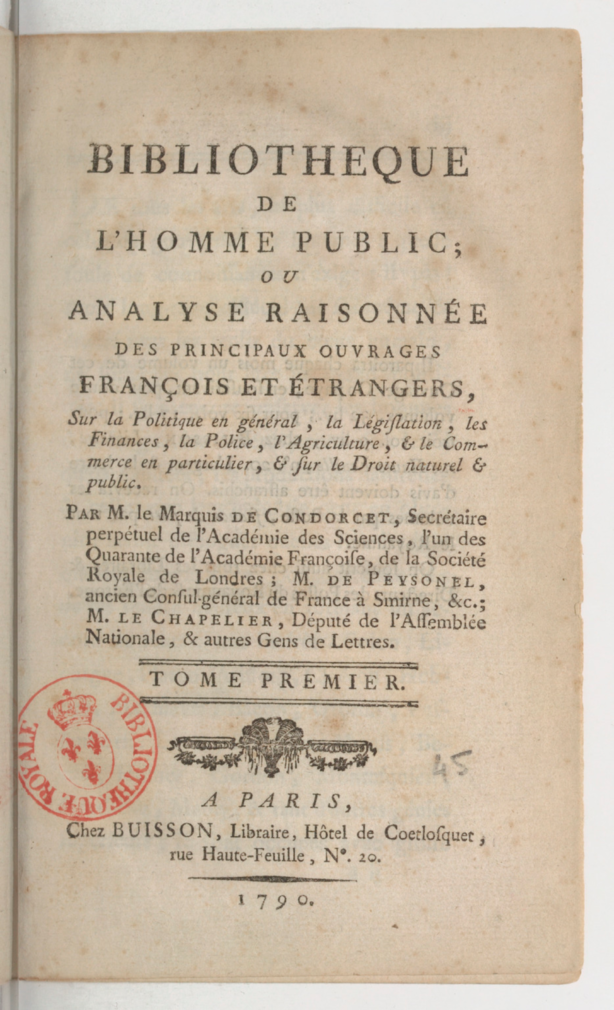- similar passage identification, such as reuses, citations, paraphrasing,
- identification of similar chapters, parts and selections, and,
- thematic and semantic relationships between documents.
The BHP was published between February 1790 and April 1792 by Condorcet and several others, spanning some 28 tomes. The full title gives an indication of the nature of the project: Bibliothèque de l'homme public et Analyse raisonnée des principaux ouvrages français et étrangers sur la politique en général, la législation, les finances, la police, l'agriculture et le commerce en particulier, et sur le droit naturel et public. (BNF Link)
It was one of numerous efforts by Condorcet to contribute to public instruction and he published a number of pieces, most notably his Cinq Mémoires sur l'instruction publique (1791) and the discussion of Smith referenced below. As Tourneux notes, however that his role was not clearly defined:
Barbier l'attribue à l'abbé Balestrier de Canilhac, dont le nom ne figure ni sur les titres, ni dans les avant-propos. Celui de Peyssonnel disparait au tome VI et Condorcet est seul nommé à partir du tome XI. Ce recueil, qui avait pour but de mettre autant que possible la science du gouvernement et de l'administration à la portée de tout le monde.... (Tourneux, Vol 2 p. 648).
Bibliothèque de l'homme public, par MM. de Condorcet, Chapelier et Peyssonnel ; le premier n'y travaillera point, le second n'y travaillera guère ; le dernier est vieux et cacochyme, il est froid et lent, deux qualités que n'avaient point Bayle, le Clerc et l'abbé Prévost.
It featured extended discussions and extracts of numerous French, English as well as classical authors, including major figures such as Aristotle, Machiavel, Bodin, Hobbes, Locke, Smith, Montesquieu, and Hume, as well a contemporary figures such as Mirabeau and Raynal and lesser known authors such as Guicciardini. While generally expository, not all of the discussions were intended to be positive:
La vivacité naturelle à l'esprit françois, l'économie du tems , l'ennui qu'entraîne un long ouvrage sur des matières, aussi sérieuses, le caractère national, tout concourt à nous faire adopter la méthode Analytique. [...] On fera connoître aussi tous les ouvrages relatifs à ce plan, à mesure qu'ils paroîtront: on se permettra même des réflexions critiques, sans toutefois blesser l'amour-propre des auteurs: la malignité aigrit, & n'éclaire pas mieux qu'elle ne corrige. (Bib homme public, 1790, vol 1 pp. vi & viii)
Smith's Wealth of Nations, for example, is extensively covered, taking up some 220 pages of the BHP. Diatkine (1993) argues that the summary is "very inaccurate", going on to suggest
[T]he summary published by Bibliotheque de I'Homme Public is the Wealth of Nations minus the 'Invisible Hand'. This shortcoming is too systematic to be attributed to a casualness of approach or to technical difficulties. We are in the presence paradox: here is a book which seems to be very important, yet completely misunderstood. (pp 219-220)
There are, of course, a great number of texts in the collects deployed in the Intertextual Hub that have many borrowed, reused, or paraphrased passages that can be identified. For example, the two volume Les délassemens d'un homme d'esprit, ou nouveau recueil de pensées amusantes, extraites des meilleurs auteurs (1780) is made up of numerous extracts (link to search) organized by theme or subject, such as chapters on SPECTACLES and JALOUSIE.
This post will be followed by others which we hope will outline the various search and navigation facilities of the Intertextual Hub with a focus on step itineraries from specific starting points.
Please do post comments below or email us at artfl@artfl.uchicago.edu.
References
Tourneux, M., Bibliographie de l'histoire de Paris pendant la Révolution française, Paris 1890-1913 (BNF)




0 comments:
Post a Comment